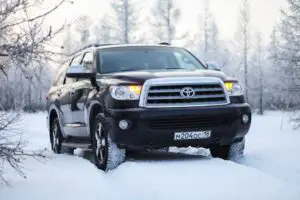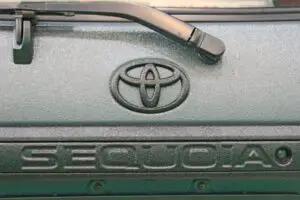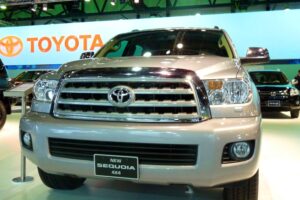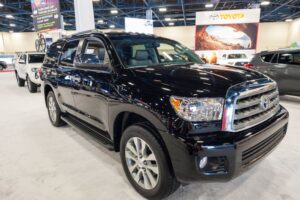The popular SUV, known as Toyota Sequoia, has been around for more than two decades, its inception in 2001.
It has been loved by many because it has a large size. When equipped with a proper engine, the truck has an amazing towing capacity, touching up to 7500 pounds.
Reliable vehicles nowadays normally do not have a steady past. That is not the case with the Toyota Sequoia. It has had a great past and has proven to be reliable.
If you are serious about buying an SUV, you should know exactly which years should not be considered. This article will focus on the best and worst years for Toyota Sequoia.
Let’s list down all of them before we get started.
Best Years for Toyota Sequoia:
- 2019
- 2009
- 2020
- 2021
- 2011
- 2018
Worst Years for Toyota Sequoia:
- 2002
- 2001
- 2003
- 2004
- 2005
- 2008
Now that all of the important years have been narrowed down let’s take a detailed look into each of them to understand why they have been placed in their respective positions.
Table of Contents
List Of The Best Years For The Toyota Sequoia: What Years To Buy

I’ll first focus on the best Sequoia models that have been in production.
All of these models have been listed above, and we will get to know what makes them so good.
So, without any further ado, let’s jump straight into it!
#1 Best Year: 2019 Toyota Sequoia
The thing about large SUVs is that they compromise a lot to allow for large cargo space. The Sequoia changed that when it arrived in the market.
The best model that represents this is 2019 Toyota Sequoia. It has been designed so that you are getting excellent performance on the road.
The suspension is top-notch, so you will not feel bumps as much as other SUVs in this class.
As the Sequoia has a V8 engine under the hood, it has been designed to provide a memorable driving experience.
The eight-passenger seating is comfortable and are perfect for long-term driving. As expected, the interior is also huge, making riding in it more comfortable.
#2 Best Year: 2009 Toyota Sequoia
Let’s backtrack a little. One of the best models of the Sequoia that Toyota ever released is the 2009 one.
This decade-old beast is still an excellent option to consider for those under a budget. This model has two engine options, a 4.7L V8 or a 5.7L one.
You can already guess which is the better between the two. The thing with large SUVs is that they tend to have poor fuel consumption.
Well, that was not the case with the 2009 model of the Sequoia. It can touch up to 19 mpg, which is pretty decent. It also has pretty much all important safety features.
#3 Best Year: 2020 Toyota Sequoia
Coming in a very close third place is the 2020 Toyota Sequoia. This model has been preferred by many due to many reasons.
It is extremely reliable, which means there have been few complaints about it. It is also one of the more recent models, which means it has the latest technology.
The 2020 Sequoia was praised for its exceptional off-roading capabilities for a large SUV. It can handle itself pretty well on the road and off of it.
It provides users with a spacious cargo space, which is more than enough for most people. In terms of the interior, it is large enough to house eight people comfortably.
#4 Best Year: 2021 Toyota Sequoia
Even the 2021 variant has made its place on this list. The thing with Sequoia is that the manufacturer has not made too many changes to it.
After all, why would you try to fix something that is not broken. The 2021 model of the SUV is the same as 2020 one.
This vehicle has the same 5.7L V8 engine under the hood. It is an excellent performer. It also has an excellent towing capacity, which many owners appreciate.
The model is the newest one, as of writing this article. It is packed with features, such as driver aid and a decent infotainment system.
#5 Best Year: 2011 Toyota Sequoia
The 2011 Toyota Sequoia is another option that one can consider. The 2011 Sequoia was praised for its excellent interior and performance.
The fact that not too many upgrades have been done means that you can get this model for a much lower price than a brand new one, despite it being over a decade old.
With the heavy SUV reaching 60 mph in 6.7 seconds, it earned one of the top spots for the quickest vehicle in its class.
The Sequoia can be used for off-roading purposes, which is rarely seen in SUVs. It also has great safety features that can come in handy.
Overall, it is a decent buy for people on a tight budget.
#6 Best Year: 2018 Toyota Sequoia
The 2018 Toyota Sequoia is a more modern option for buyers that want to buy this beastly SUV on a smaller budget.
It performs very similarly to the 2019 one, which has earned the top spot on this list.
The 2018 model is fairly recent, which means that it has almost all of the latest tech that you can find on the 2021 model.
The 2018 Sequoia has earned the last spot on this list for two reasons. The first one is that its fuel economy is not good compared to its successor.
Another thing is that the included infotainment system is too small. This frustrated many users. It is a good buy, but you have to make some sacrifices.
List Of The Worst Years For The Toyota Sequoia: What Years To Avoid

It must be noted that the years that will be discussed below have been pretty reliable.
They had their fair share of issues, but some can be considered if one is willing to fix the problems.
It is still recommended to consider the previous list to ensure a pleasant experience.
#1 Worst Year: 2002 Toyota Sequoia
Well, the worst Sequoia model award goes to 2002 one.
This variant is exactly two decades old, as of writing this article. It has, by far, the greatest number of complaints out of any other model.
Owners reported that different error lights would come on, which would cause a lot of concern.
There was another common complaint of the handles breaking off. This is rarely heard of, but it did cause a lot of frustration.
There were a few reports of engine and transmission failure too. The engine would unexpectedly die, which can result in a serious accident.
#2 Worst Year: 2001 Toyota Sequoia
The 2001 Toyota Sequoia, which was released a year earlier, surprisingly had a completely different set of problems.
Most of them were related to the brakes, but steering and paint issues were.
The traction control lights would engage, which would confuse the driver. The stability assist system would also glitch out, which means it cannot be relied on.
The steering system on the 2001 Sequoia was unreliable at times. Owners complained that the vehicle would jerk to the side automatically, which could cause a serious accident.
There was also the issue of rusting, which significantly reduced the lifespan of the SUV.
#3 Worst Year: 2003 Toyota Sequoia
Things did not get better in 2003, with the model having both 2002 and the 2001 models.
Most of them were related to the electrical system, but there were complaints about the paint and brakes.
Users reported that the ABS lights would come on randomly, which meant it was engaged.
Handle failure was also very common in this model. There were complaints about the rear hatch handle failing.
The worst issue was where the brakes would stop working completely, which meant there was no safe way to put the vehicle to a stop.
#4 Worst Year: 2004 Toyota Sequoia
You would expect that Toyota would have fixed these problems a few years later. That was certainly not the case.
The 2004 Toyota Sequoia exhibited similar issues, which caused headaches for too many owners.
Owners complained that the rear hatch handle would break, which would result in the trunk not being accessible. The isolation of the 2004 model was not good either.
There were reports of excessive wind noise when traveling at high speeds.
The power windows would also stop working at intervals, which made the experience of owning this model unpleasant.
#5 Worst Year: 2005 Toyota Sequoia
As was disclosed before, the worst models of the Sequoia were released around the same time.
They had similar issues. The spark plugs would blow out unexpectedly, which would result in the vehicle stopping in the middle of the road.
The problems were a bit different on the 2005 Toyota Sequoia model. There were also reports of the SUV not accelerating at all.
The gas pedal would be depressed, and pressing on it would do nothing. The fuel system would fail too and would send out warning signs. This is an expensive repair.
#6 Worst Year: 2008 Toyota Sequoia
Finally, coming in the sixth and final place is the 2008 model of the Toyota Sequoia. The issues with this model were mostly related to the interior.
The seat belts would not recoil after use, and the radio would sometimes stop working. Although this model has fewer serious issues, owning it is extremely inconvenient.
There were also complaints about this model rusting, which severely shortened the lifespan by compromising the structure of the SUV.
Finally, the problem of the camshaft towers leaking was another source of contention for many owners.
What Are The Most Common Problems With The Toyota Sequoia?
Although the recent models of the Sequoia have been exceptionally reliable, the older ones had some varying issues, with most of them being discussed above.
This section of the article will focus on the most common ones and their causes.
1. Transmission Failure
Transmission failure was one of the most common problems with the Toyota Sequoia. The problem was mostly seen in the 2002 model, the worst model that one can buy.
Users complained that their vehicles would not shift gears properly, which would result in shaking.
It is also reported that the problem was seen after the SUVs had more than 100000 miles on the odometer.
The transmission failure resulted in unexpected stalling of the vehicle in the middle of the road, resulting in a serious accident.
So, what could cause a transmission failure?
Well, there can be many factors that can cause this issue. It could be a solenoid on the converter or damaged seals. They are the most common sources of transmission issues.
Related: What Are The Toyota Sequoia Transmission Problems?
2. Automatic Brakes Activating
The earlier models of the Sequoia had the problem of the braking system activating automatically. This usually happens when the vehicle was traveling at high speeds.
Owners reported that this would result in the vehicle shifting from left to right. The brakes would also engage, causing a loud grinding sound. This issue was discussed above.
The problem was reported by a small minority of people, which means that it was not a design flaw.
Surprisingly, Toyota never issued a recall for this problem, despite its presence for so many different years. It was seen mostly in pre-2005 models.
3. Frame Rusting Issue
Although this problem has been solved on all models of the Sequoia that were released after 2010, it complained about a lot before that.
There were reports of the frame of the SUV rusting, which would compromise the structural integrity of the vehicle itself.
The problem is serious because rusting can greatly reduce a vehicle’s lifespan.
It has been reported that Toyota did not use anti-corrosion chemicals with some of the models, which resulted in the frame rusting.
These chemicals cover the frame, preventing moisture and oxygen from combining. This is a serious issue, and some owners also filed lawsuits against the manufacturer.
The lawsuit was won, which resulted in many 2005 to 2008 Sequoias being recalled and fixed. If you have a truck with this issue, you should get it professionally checked.
You should also look for service bulletins for this specific issue.
Related: Why Won’t My Toyota Sequoia Start?
Frequently Asked Questions
Q1. What Is The Life Expectancy Of A Toyota Sequoia?
Many factors can affect the life expectancy of a Toyota Sequoia, but as long as you keep up with routine maintenance, it should last for at least 300000 miles.
That is very impressive. Most SUVs in the same class are expected to last around 200000 miles.
You can push this number even further with timely maintenance and not delaying needed repairs.
Q2. What Year Did The Sequoia Body Style Change?
The third generation of the Sequoia will be released in 2023. The SUV is more than two decades old at this point.
You will be surprised to know that there has been only a total of two generations of this popular SUV. This means that there has been one style change only.
The change was revealed to the public in 2007. The shape was and still is in the market.
Q3. Do Toyota Sequoias Hold Their Value?
Almost all Toyota vehicles have an excellent resale value. The same is the case with Sequoia.
According to different researches, the vehicle will retain around 63% of its value after three years. The number will drop down to 56% in two more years.
This means that you will be able to sell your SUV at a decent rate, even after a few years of use. So, you don’t need to be quick to sell it and buy a new one.
Q4. Does Toyota Sequoia Require Premium Gas?
The only vehicle in the entire Toyota lineup that requires premium gas is the Toyota Supra, and that is because it uses a BMW engine.
Simply put, the Sequoia uses regular gasoline. You don’t need to spend extra to get premium gas for your SUV.
Although gas with a higher grade will result in better combustion, leading to improved fuel efficiency, the difference will not be that great.
Q5. Is A Toyota Sequoia Built On A Tundra Frame?
Yes, it is! The Sequoia was manufactured with the base platform of the Tundra.
This has been the case with the second generation and even the upcoming third generation, which will be available in 2023.
There are still some differences, such as the Sequoia having a boxed frame and an independent rear suspension system.
In layman terms, yes, the Sequoia is the SUV version of the Tundra.
Conclusion
If you’re looking for a safe, reliable SUV that has a ton of cargo space, then the Toyota Sequoia is a great choice for you.
It has remained one of the bestselling models in its class since its release nearly 20 years ago.
Regardless of the model you choose, it checks all the right boxes to provide you with a memorable driving experience.
But, if you want one on a whole other level, I recommend the 2019 one. If you are on a tighter budget, 2009 will be perfect for you.
I hope that this article helped you become aware of the best and worst years for Toyota Sequoia.

I am Tahir Azam, and I have been writing amazing articles for TaxiHack for as long as I can remember. I know everything that is to know when it comes to automobiles and is always on top of industry news and developments. While I am not an expert by any means, I pride myself on knowing the ins and outs of many different problems and, of course, their solutions. The articles on our website are some of the best and well-researched content that you will find, and I spend countless hours making sure this remains to be true. This is why I ask you to take your time out and read some of my articles, especially if you find a topic that resonates with you or is something you are looking into. This way, you will find the perfect mix of information and tips on your desired topic. Learn more about Tahir.


